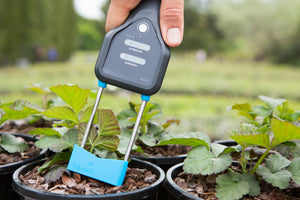LEC 315 Ceramic Metal Halide
In the world of HID lighting for horticulture, Double Ended (DE) fixtures have been getting all the attention, but there is another HID fixture that some growers may have naturally overlooked. Ceramic Discharge Metal halide (CDM) is also marketed as Ceramic Metal Halide (CMH) and Light Emitting Ceramic (LEC). All of these are the same technology. Ceramic lamps tend to run at a lower, fixed wattage, and their potential to save energy is often their most touted feature, so they may not be as exciting as that fully adjustable DE fixture that you can crank to 1175watts. To fully appreciate the difference and why they deserve your attention, It’s best to see plants growing under an LEC firsthand. Here are some of the reasons why you should take a field trip to your local Way to Grow today to see the difference for yourself.
Quality over Quantity
Ceramic lighting tech has been available for some time. They were first marketed for use in retail and commercial fixtures as an alternative to unnatural-looking yellow-orange HPS bulbs or traditional Metal Halides which dim and burn out more quickly. Similar to a standard HPS bulb except the filament runs at a higher temperature giving them a high Color Rendering Index (CRI), truer to natural sunlight. The upshot was a lamp with the long life of an HPS. As well as a spectrum that couldn’t be matched by the best metal halides, and also capable of putting out excellent PAR measurements.
Grower Tested, Industry Approved
Naturally, when growers first stumbled on the specs for these retail bulbs It seemed a little too good to be true. Once people started using them and showing off the difference they made in their plants, ceramic lamps gained a following and the industry began to notice. We can talk PAR, spectrum, and PPFD all day. And yes LEC lamps do excel in those areas, but perhaps more compelling is the fact that this tech was discovered “in the field” by growers just like you. It has been researched and vetted not in labs but in garages, basements, and warehouses. This is a product that pushed its way into the market and onto grow room shelves as a response to consumer demand.
The Other Bits and Pieces
We’ve been focused mainly on the lamp since most of the LEC fixtures on the market will use either one or two 315watt bulbs. Even considering the improved spectrum, it may not seem like a small wattage bulb could keep up with fixtures pulling nearly twice the power as many growers had been claiming. The ballasts that drive the new lamps are also much improved over the standard magnetic coil ballasts that are used with most metal halide lamps. Just like DE fixtures, the digital ballasts which drive the new LEC lamps use new “digital square wave technology” which means the ballast spends more of its time at the maximum voltage/light output.
The lower wattage draw means less heat to dissipate even though the lamp element itself is at a higher temperature. This allows the new LEC fixtures to be run open without a lens, keeping the bulb at optimum temperature (and therefore spectrum) without a heavy glass lens, which can rob 10% or more of light output. So now we know it’s a combination of the wide spectrum lamp, efficient ballast, and ideal reflector design that allows these fixtures to perform so well compared to lamps drawing much more power.
Applications Well Suited for LEC
While there is both bloom (3100k) and veg (4200k) spectrum LEC bulbs available, either bulb is dual purpose. That doesn’t mean they’re the best lamp in all circumstances, though. Despite all of their advantages, the 315w LEC does have a smaller effective footprint compared to a 600w or 1000w HPS. For some gardens that may be just right, like when working with a small space, or limited power overhead. We’ll wrap up with some of our favorite uses of LEC fixtures.
Propagation Station:
A single 315watt LEC fixture can easily replace two, 2’x4’ T5 fixtures in your cloning and propagation area. This provides the ideal amount of light without having to worry about excess heat or having to move the lights while saving power to boot.
Most Veg Rooms:
Having vegged with everything from CFLs to T5s to metal halides of every brand and wattage, I can safely say that ceramic fixtures produce the best results that I have ever seen during the vegetative phase. I’m not making any claims about growth rate, I’m simply talking about overall plant health and vigor. You can see it in the size and color of the leaves, how thick the stems are and how much lateral branching there is. LEC lamps are always at the top of the list when it comes to recommending a new lamp for a veg area.
Supplemental Lighting in Bloom:
LECs are a great way to give your plants flowering under HPS that little extra something they need to reach maximum potential.
Smaller grows without separate Veg and Bloom:
If you veg in the same area that you flower in, it can be a hassle to buy extra bulbs, store them and swap them. The low power consumption and low heat dissipation can also really help when you’re in a tight area or are already running at the limit of your cooling/airflow.
Limited Power availability:
Not every grow area has easy access to a 50 amp sub-panel or dryer hookup. Not all properties can be easily modified or upgraded. If you’re working with older wiring or a limited number of amps, it may be much more practical to use LECs.
If you have any questions about ceramic lighting, using LECs, or have other suggestions on how to utilize them, feel free to contact us!
